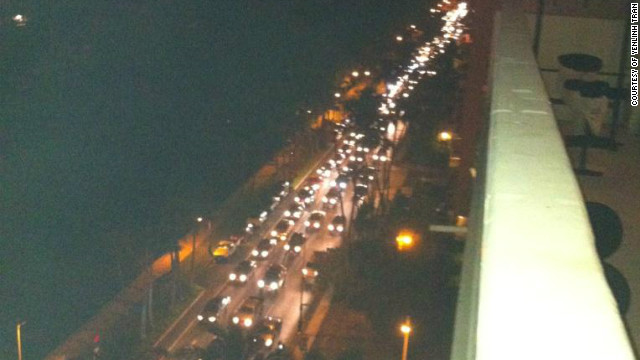
(CNN) — After barreling across the Pacific Ocean for hours, a tsunami spawned by an earthquake in Canada struck the Hawaiian islands.
Waves between 3 and 7 feet were expected to lash the islands beginning about 10:28 p.m. Saturday (4:28 a.m. Sunday ET), the Pacific Tsunami Warning Center said.
The first waves to hit Honolulu didn’t seem much stronger than usual.
But scientists said don’t be fooled by the initial waves, which often aren’t the biggest.
“It’s not just one wave, it’s a succession of waves,” Gerard Fryer, senior geophysicist at the center, told reporters. “The following waves, I am sure, will be bigger.”
Read the latest developments in our live blog
But he noted that the tsunami will not be as significant as the devastating quake and tsunami that killed thousands in Japan in March 2011.
Local television showed images of bumper-to-bumper traffic on roads leading from the coast to inner ground. About 80,000 people live in evacuations zones in the island of Oahu, the island where Honolulu is located.
John Cummings, spokesman for Honolulu Emergency Management, said officials have opened 26 centers for evacuees.
“All islands and all shorelines will be affected when it comes in,” Cummings said.
Honolulu Mayor Peter Carlisle urged residents who are already on higher ground to not clog traffic. Officials expressed concerns about emergency vehicles getting by in heavy traffic.
But the tsunami warning came at an unfortunate time — when thousands of revelers packed streets in Honolulu for the annual Hallowbaloo festival.
Even Hawaiians accustomed to tsunami warnings spared no effort in bracing for the worst.
Honolulu resident Victoria Shioi filled her bathtub with water, set her refrigerator to the coldest setting and gathered candles in case of water or power outages.
“Also backed up my computer and put the external (hard drive) in the waterproof safe,” Shioi said.
The tsunami was spawned by an earthquake in western British Columbia, prompting a local tsunami warning and sending some residents toward higher ground.
“A (magnitude) 7.7 is a big, hefty earthquake — not something you can ignore,” Fryer said. “It definitely would have done some damage if it had been under a city.”
Instead, the quake struck about 139 kilometers (86 miles) south of Masset on British Columbia’s Queen Charlotte Islands. No major damage was reported.
The Alaska Tsunami Warning Center issued a warning for western British Columbia from Vancouver to the southern panhandle of Alaska.
Canadians as far as Prince Rupert on mainland British Columbia felt the quake.
Tanya Simonds said she felt like her house was “sliding back and forth on mud,” but didn’t see any damage from the tremor.
Shawn Martin was at a movie theater when the quake struck.
“It just felt like the seats were moving. It felt like someone was kicking your seat,” he said.
Martin said more than hundred cars headed toward a popular intersection in the city known for its higher ground.
Thousands of miles across the Pacific, residents in Hawaii did the same.
“The rest of the Pacific does not have to worry, but Hawaii does,” Fryer said.
CNN’s Joe Sutton, Chandler Friedman, Maggie Schneider and Chelsea J. Carter contributed to this report.
Source Article from http://edition.cnn.com/2012/10/28/world/americas/canada-earthquake/index.html?eref=edition
Tsunami arriving toward Hawaii after major quake
No comments:
Post a Comment